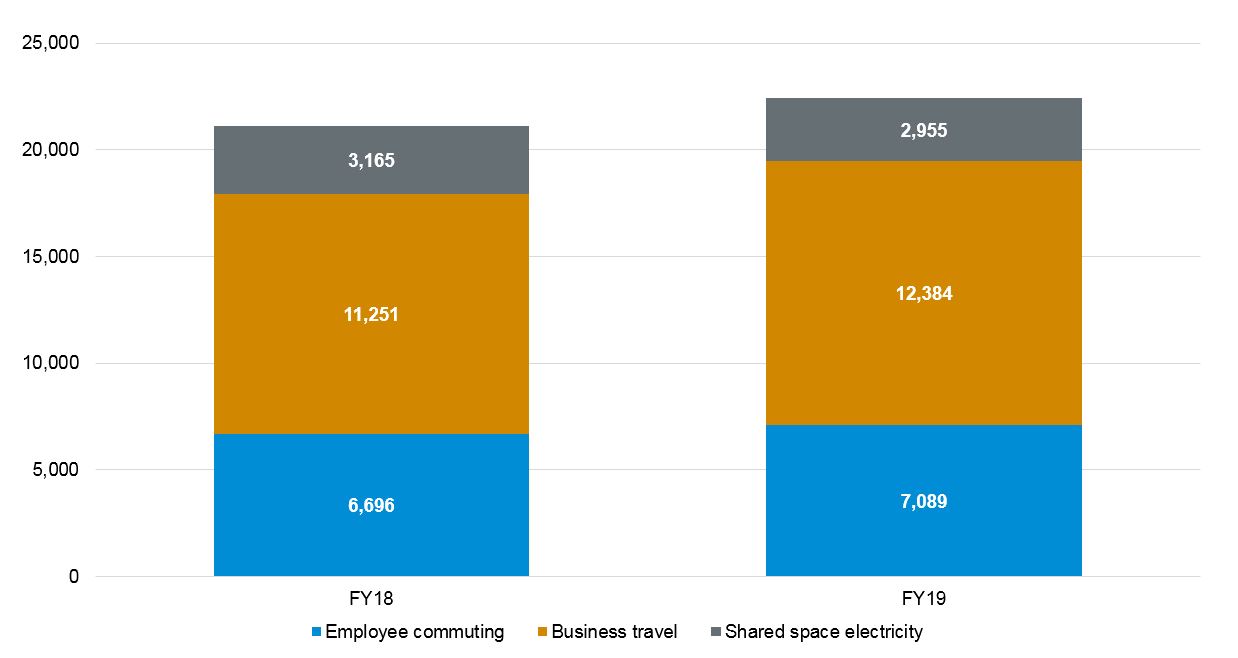Scope 1 and 2 emissions FY17 – FY19 (tCO2e) ¹ ²
| Method | FY17 | FY18 | FY19 | |
|---|---|---|---|---|
| Scope 1 | 1,392 | 1,400 | 1,389 | |
| Scope 2 | Location based | 3,939 | 3,681 | 3,503 |
| Market based | 3,906 | 3,681 | 3,491 | |
| Total | 5,298 | 5,081 | 4,880 |
1 Scope 1 includes direct emissions from operations we own or control. Scope 2 includes indirect emissions from the generation of purchased electricity, heating, cooling and steam that we consume or use.
2 FY18 Scope 2 emissions were recalculated and restated as a result of increased activity data accuracy used as the basis of estimated data. This resulted in a 332 tCO2e (10%) increase to the values previously reported in the FY18 Sustainability Report (3,328 tCO2e). The impact of the recalculation on the FY17 and earlier figures was deemed to be immaterial and did not warrant a prior period adjustment.
Science-based targets Scope 1 and 2 trajectory ¹
1 ERM has set a science-based target against 100% of Scope 1 and 2 emissions. The FY14 base year and FY25 target are shown in the graph. ERM is on track to meet this target, with the performance following the science-based target reduction path.
GHG emissions intensity Scope 1 and 2 FY17 – FY19 (tCO2e/FTE)¹
1 Scope 1 and 2 emissions normalized by average full-time equivalent (FTE) employees.
Scope 3 emissions FY18 – FY19 (tCO2e) ¹ ² ³

| Scope 3 | ||
|---|---|---|
| FY18 | FY19 | |
| Europe, Middle East and Africa | 3,782 | 3,857 |
| Asia Pacific | 3,404 | 3,288 |
| Latin America and Caribbean | 1,238 | 1,340 |
| North America | 11,260 | 12,381 |
| Global Businesses | 434 | 563 |
| Group | 995 | 998 |
| Total | 21,112 | 22,427 |
1 Scope 3 emissions include our indirect emissions from business travel, employee commuting and shared space electricity.
2 FY18 base year was recalculated to reflect new activity data for employee commuting, a new methodology and more specific emission factors (see references). Our reduction target from FY18 to FY25 remains the same.
3 Scope 3 emissions in North America increased due to a large project resulting in a 7% increase in North America business travel.
Science-based targets Scope 3 trajectory ¹
1 ERM has set a science-based target for business travel and employee commuting, covering 73% of the total Scope 3 inventory.
GHG emissions intensity Scope 3 FY18 – FY19 (tCO2e/FTE) ¹
1 Scope 3 emissions from business travel and employee commuting normalized by average full-time equivalent (FTE) employees.
Global office energy use FY17 – FY19 (MWh) ¹ ² ³
| Scope 2 | Scope 1 and 2 | Scope 1 and 2 | Scope 3 | |||||||||
|---|---|---|---|---|---|---|---|---|---|---|---|---|
| Office electricity | RECs electricity | Fuel consumption | Other electricity | |||||||||
| FY17 | FY18 | Fy19 | FY17 | FY18 | FY19 | FY17 | FY18 | FY19 | FY17 | FY18 | FY19 | |
| Total (MWh) | 7,987 | 7,996 | 7,649 | 256 | 139 | 302 | 2,759 | 3,034 | 2,954 | 7,625 | 6,508 | 5,699 |
1 Office electricity consumption is restated by 501 MWh (3% of total energy use) in FY18, due to more precise measurement of our office electricity and new activity data.
2 Renewable Energy Certificate (REC), i.e. the tradeable part of generated electricity from renewable resources representing attributes such as GHG emissions.
3 Shared electricity is the portion of shared resources for which ERM is responsible in multiple-occupant buildings. This category does not fall under ERM’s science-based targets.
Data presented here supports the Climate change section of this report. All data has been calculated using a market-based approach, unless otherwise stated.The emissions data presented includes data from the BrownFlynn acquisition. Emissions data normalized by average full-time equivalent (FTE) employees to reflect this in the intensity graphs. All 2019 ERM acquisitions are included in the Health and Safety data starting the date of the acquisition. Our People data includes the complete data sets from BrownFlynn and MP&A.
All emission data presented is expressed as carbon dioxide equivalent (CO2e) and includes all Kyoto gases and refrigerants. ERM uses the Fifth Assessment Report as a source of Global warming potential (GWP) without Climate feedback. The detailed reference table can be found below.
| Gas | Activity | Geography | Reference |
|---|---|---|---|
| CO2, CH4, N20 | Passenger car (all sizes and fuel types) | Europe | Department for Business, Energy and Industrial Strategy (2018). 2018 Government GHG Conversion Factors for Company Reporting. |
| CO2, CH4, N2O | Passenger car (all sizes and fuel types) | North America and countries outside of Europe | EPA (2018). GHG Emission Factors Hub. Center for Corporate Climate Leadership. March 2018. |
| CO2, CH4, N2O | Gasoline car | Canada | EC (2018). National Inventory Report. Greenhouse Gas Sources and Sinks in Canada: 1990 - 2016. Environment Canada. |
| CO2, CH4, N2O | Gasoline and Diesel cars | Australia | Commonwealth of Australia 2018 (Department of the Environment and Energy). National Greenhouse Account Factors (NGA) - Australian National Greenhouse Accounts. July 2018. |
| CO2, CH4, N2O | Petrol car | New Zealand | New Zealand Government (2016). Ministry for the Environment: Guidance for Voluntary Corporate Greenhouse Gas Reporting - Data and Methods for the 2014 Calendar Year. |
|
CO2, CH4, N2O |
Petrol and Diesel use | Europe | Department for Business, Energy and Industrial Strategy (2018). 2018 Government GHG Conversion Factors for Company Reporting. |
|
CO2, CH4, N2O |
Gasoline and Diesel use | North America and outside of Europe |
EPA (2018). GHG Emission Factors Hub. Center for Corporate Climate Leadership. March 2018. |
| CO2, CH4, N2O | LPG | South America | |
| CO2, CH4, N2O | Motorcycle | Global | Department for Business, Energy and Industrial Strategy (2018). 2018 Government GHG Conversion Factors for Company Reporting. |
| CO2, CH4, N2O | Taxi | Europe | Department for Business, Energy and Industrial Strategy (2018). 2018 Government GHG Conversion Factors for Company Reporting. |
| CO2, CH4, N2O | Trucks | USA and countries outside Europe | EPA (2018). Inventory of U.S. Greenhouse Gas Emissions and Sinks: 1990-2016. United States Environmental Protection Agency. |
| CO2 | Auto-Rickshaw | Asia | India GHG Program, India Specific Road Transport Emission Factors (2015). |
| CO2, CH4, N2O | Bus | Europe | Department for Business, Energy and Industrial Strategy (2018). 2018 Government GHG Conversion Factors for Company Reporting. |
| CO2, CH4, N2O | Bus | North America and outside of Europe |
EPA (2018). GHG Emission Factors Hub. Center for Corporate Climate Leadership. March 2018. |
| CO2, CH4, N2O | Light rail | Global | Department for Business, Energy and Industrial Strategy (2018). 2018 Government GHG Conversion Factors for Company Reporting. |
| CO2, CH4, N2O | National rail | Europe | Department for Business, Energy and Industrial Strategy (2018). 2018 Government GHG Conversion Factors for Company Reporting. |
| CO2 | National rail | Japan |
Central Japan Railway Company (2010). Environmental Report 2010. Available online: |
| CO2, CH4, N2O | National rail (intercity) | North America and outside of Europe |
EPA (2018). GHG Emission Factors Hub. Center for Corporate Climate Leadership. March 2018. |
| CO2 | AVE train |
Spain | |
| CO2e | TGV train | Europe | SNCF (2018). INFORMATION SUR LA QUANTITE DE GAZ A EFFET DE SERRE EMISE A L’OCCASION D’UN PRESTATION DE TRANSPORT. |
| CO2e | Thalys train | Europe | Thalys (2016). Thalys Carbon Footprint 2016. |
| CO2, CH4, N2O | Eurostar | Europe | Department for Business, Energy and Industrial Strategy (2018). 2018 Government GHG Conversion Factors for Company Reporting. |
| CO2, CH4, N2O | Underground | Global (except North America) | Department for Business, Energy and Industrial Strategy (2018). 2018 Government GHG Conversion Factors for Company Reporting. |
| CO2, CH4, N2O | Transit rail | North America |
EPA (2018). GHG Emission Factors Hub. Center for Corporate Climate Leadership. March 2018. |
| CO2, CH4, N2O | Ferry | Global | Department for Business, Energy and Industrial Strategy (2018). 2018 Government GHG Conversion Factors for Company Reporting. |
| CO2, CH4, N2O | Flights – all hauls and classes | Global | Department for Business, Energy and Industrial Strategy (2018). 2018 Government GHG Conversion Factors for Company Reporting. |
| CO2, CH4, N2O | District heating (natural gas CHP) | Global | IPCC (2006). Revised IPCC Guidelines for National Greenhouse Gas Inventories: Reference Manual. Intergovernmental Panel on Climate Change. Cambridge University Press, Cambridge. |
| CO2, CH4, N2O | District heating (steam) | North America | EPA (2018). GHG Emission Factors Hub. Center for Corporate Climate Leadership. March 2018. |
| CO2, CH4, N2O | Electricity (including Transmission and Distribution Losses (T&D losses) | UK . | Department for Business, Energy and Industrial Strategy (2018). 2018 Government GHG Conversion Factors for Company Reporting |
| CO2, CH4, N2O | Electricity (including T&D losses) | USA | EPA (2018). eGrid2016. Release: 2/15/2018. |
| CO2, CH4, N2O | Electricity (including T&D losses) | Canada | EC (2018). National Inventory Report. Greenhouse Gas Sources and Sinks in Canada: 1990 - 2016. Environment Canada. |
| CO2, CH4, N2O | Electricity (including T&D losses) | Global (except UK, USA and Canada) | IEA (2018). Statistics. http://www.iea.org/stats/index.asp.# IPCC (2006). Revised IPCC Guidelines for National Greenhouse Gas Inventories: Reference Manual. Intergovernmental Panel on Climate Change. Cambridge University Press, Cambridge. |
| CO2e | Electricity (excluding T&D losses) | Australia | Commonwealth of Australia 2018 (Department of the Environment and Energy). National Greenhouse Account Factors (NGA) - Australian National Greenhouse Accounts. July 2018. |
| CO2e | Electricity residual mix | Europe | AIB (2018). European Residual Mixes 2017. Version 1.13, 11th June 2018. Association of Issuing Bodies. |
| CO2, CH4, N2O | Natural gas | Canada | EC (2018). National Inventory Report. Greenhouse Gas Sources and Sinks in Canada: 1990 - 2016. Environment Canada. |
| CO2, CH4, N2O | Natural gas | Europe | AIB (2018). European Residual Mixes 2017. Version 1.13, 11th June 2018. Association of Issuing Bodies. |
| CO2, CH4, N2O | Natural gas | Australia | EC (2018). National Inventory Report. Greenhouse Gas Sources and Sinks in Canada: 1990 - 2016. Environment Canada. |
| CO2, CH4, N2O | Natural gas | USA | Commonwealth of Australia 2018 (Department of the Environment and Energy). National Greenhouse Account Factors (NGA) - Australian National Greenhouse Accounts. July 2018. |
| HCFC-123, R11, R12, R401a, HFC-134a, R407c, R410a | Refrigerants | Global | IPCC (2013). IPCC Fifth Assessment Report: Climate Change 2013. Intergovernmental Panel on Climate Change. Cambridge University Press, Cambridge. |
